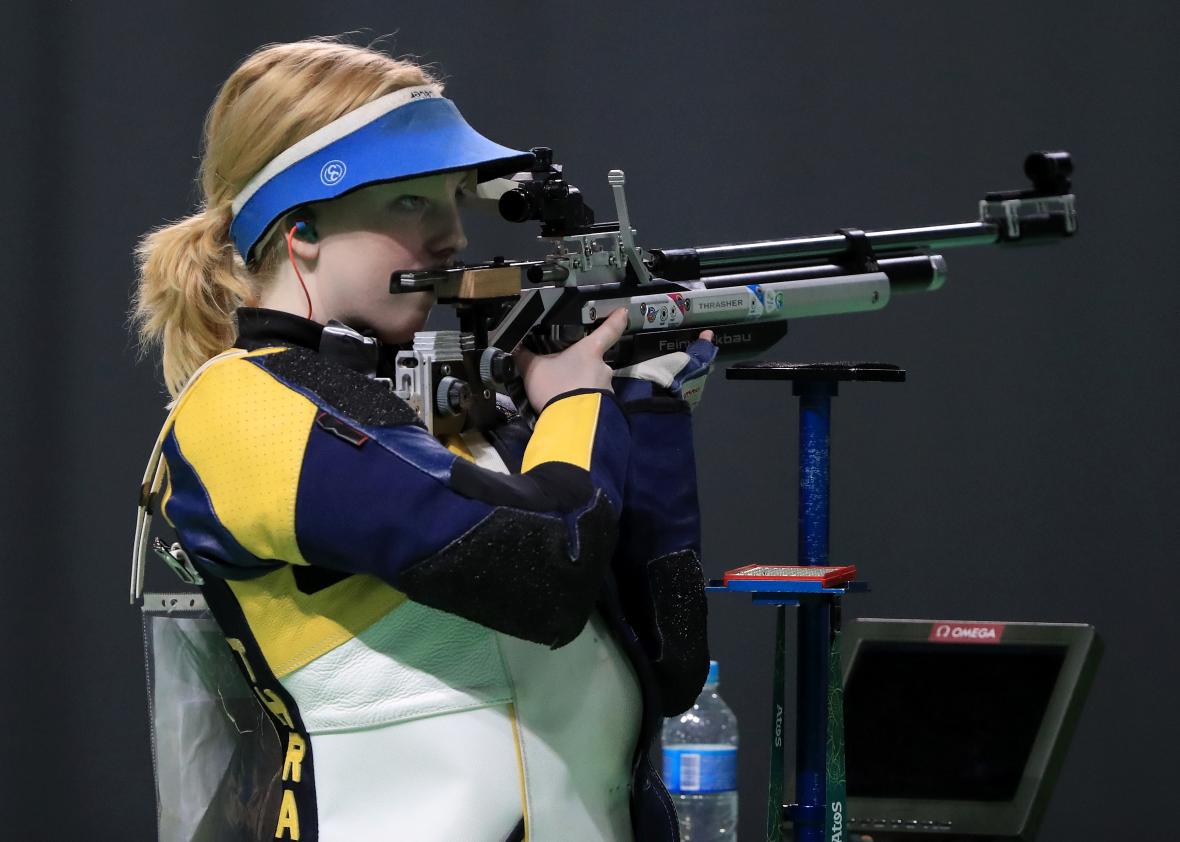On Saturday morning in Rio de Janeiro, 19-year-old American shooter Virginia “Ginny” Thrasher made a small bit of history when she became the first gold medalist in the 2016 Summer Olympics. Thrasher’s gold came in the 10-meter air rifle, an obscure event about which I, and presumably you, knew absolutely nothing. Here’s what I’ve learned.
Who is Ginny Thrasher?
Thrasher is a 19-year-old Springfield, Virginia, resident who is currently enrolled as a rising sophomore at West Virginia University, where she competes on the school’s national champion intercollegiate coed rifle team.
Wait, riflery is an intercollegiate sport?
Yes, and Thrasher might be the best intercollegiate shooter in the country. At the NCAA Championships this spring, she took first place in the individual smallbore and air rifle events, and won the Top Performer Award. These accomplishments are even more impressive when you learn Thrasher has been shooting for only five years.
Smallbore? Air rifle? Top Performer? What do these words mean?
As far as I understand it, “top” means best and “performer” means singer/songwriter, so clearly the NCAA was rewarding Thrasher for her musical ability. “Smallbore” is a competitive shooting discipline in which participants fire a .22 caliber rifle at a target from a distance of 50 feet. An air rifle is a lightweight firearm—according to the official rulebook of the International Shooting Sport Federation, the governing body for all Olympic shooting events, air rifles in competition can weigh no more than 5.5 kilograms, or a bit more than 12 pounds—in which the propulsive force comes from gas or compressed air. Air rifles fire small, 4.5-millimeter pellets made of “lead or other soft material,” again according to the ISSF.
So an air rifle is basically a pellet gun? Like the gun that Ralphie wanted in A Christmas Story?
Yes, and competitive shooters must take great care to avoid shooting their eyes out or licking frozen flagpoles in response to their rivals’ triple dog dares.
I heard somewhere that Olympic air rifles fire “invisible pellets.” Is this so?
What? No. This isn’t Duck Hunt, people. The ISSF rulebook makes very clear that competition air rifles fire .177 caliber pellets, which, while admittedly very small, are certainly visible. The “Shooting 101” primer on the NBC Olympics website says the same thing. These are actual air rifles that fire actual ammunition, not magical rifles that fire magical pellets that only elves can see.
Let’s leave elves out of this. How does competitive air riflery actually work?
Shooters aim at targets that are divided into rings. Those rings are set at five-millimeter intervals, and they circle a half-millimeter dot that serves as a bull’s-eye. Shots are scored individually on a scale of 1 to 10.9; the closer you come to the center, the higher the score you receive.
In the final round of a competition—which, let’s be honest, is the only round that you or I care about—the eight shooters with the highest scores in the qualification round face off in a 20-shot match. After eight shots, the finalist with the lowest cumulative score thus far is eliminated, and so it goes for every two shots thereafter, until just two shooters remain.
And this is where the “mind games” come in?
Sort of, yeah. In the clip below, Thrasher and China’s Li Du have 50 seconds to fire each shot, but it’s up to each shooter to decide exactly when in that 50-second span to fire. Mind games!
Why is air riflery an Olympic sport?
Well, why is equestrianism an Olympic sport?
Why won’t you just answer the question?
I’m trying! Look, the Olympics basically began as a meet-and-greet field day sort of thing for the world’s military officers, which is why the Summer Games initially included so many events you might expect to see on a fin-de-siècle battlefield. Today, there are 15 different shooting events at the Summer Olympics. Air rifle didn’t become an Olympic sport until the 1984 Los Angeles Games, though. That was the year women’s shooting debuted at the Olympics. So the air rifle, really, is one of the most important implements in the history of the feminist movement.
What’s the deal with the weird shooting suits worn by the competitors?
You mean those Swiss Guard–meets–Mad Max jackets?

Pascal Guyot/AFP/Getty Images
Yes!
This is a very good question. So, first of all, the uniforms are highly functional. Air riflists wear padded leather or canvas jackets to maximize stability. Basically, the shooting suits are very heavy, and bind up the shooter so it’s easier to take a steady shot. For more on this, let’s hand it over to Jessie Duff of NRA All Access:
Thanks, Jessie Duff of NRA All Access!
You’ve explained the function, now what about the form?
The rulebook of the International Shooting Sport Federation states that the clothing worn by athletes in “international-class” competitions must “convey positive images of shooting athletes as Olympic sport athletes.” While the ISSF encourages competition shooters to wear something that “incorporates or displays national, NOC [National Olympic Committee], or National Federations colors or emblems,” this does not appear to be a hard and fast rule. Ginny Thrasher’s shooting suit at the Olympics is the same one she wears in intercollegiate competition. It is gold and blue because those are the colors of West Virginia University. If Thrasher comes back in 2020, I’m hoping she gussies it up a little bit, perhaps adding an eagle clutching an air rifle in its talons and with a gold medal tucked inside its beak.
